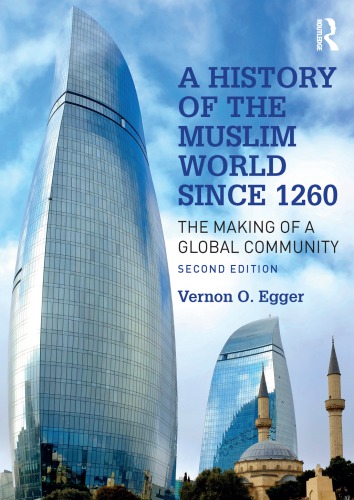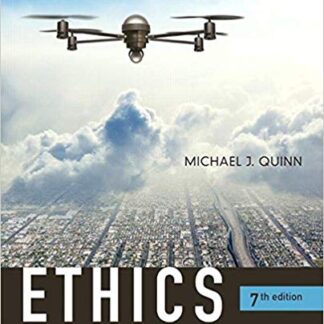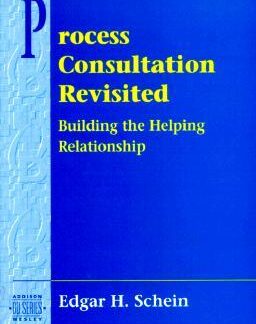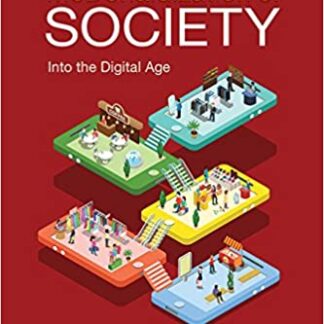Description
A History of the Muslim World since 1260: The Making of a Global Community 2nd Edition, ISBN-13: 978-1138742482
[PDF eBook eTextbook] – Available Instantly
- Publisher: Routledge; 2nd edition (April 30, 2018)
- Language: English
- 578 pages
- ISBN-10: 1138742481
- ISBN-13: 978-1138742482
A History of the Muslim World since 1260 continues the narrative begun by A History of the Muslim World to 1750 by tracing the development of Muslim societies, institutions, and doctrines from the time of the Mongol conquests through to the present day. It offers students a balanced coverage of Muslim societies that extend from Western Europe to Southeast Asia. Whereas it presents a multifaceted examination of Muslim cultures, it focuses on analysing the interaction between the expression of faith and contemporary social conditions.
Table of Contents:
Cover
Half Title
Title Page
Copyright Page
Table of Contents
List of Figures
List of Maps
Preface
Acknowledgments
Note on Transliteration, Dating, and “the Muslim World”
Introduction The Making of a Civilization, 610–1260
The Formative Period, 610–950
A Civilization under Siege, 950–1260
Part One Mongol Hegemony, 1260–1405
Chapter 1 The Great Transformation
The Mongol Khanates
The Golden Horde
The Il-khanate
The Chaghatay Khanate
New Centers of Islamic Culture
The Mamluk Empire
The Delhi Sultanate
The Ottoman Sultanate
Scourges
Plague
Timur Lang
Conclusion
Further Reading
Chapter 2 Unity and Diversity in Islamic Traditions
Intellectual Life in the Fourteenth Century
The End of the “Golden Age”?
Against All Odds
Law
The Queen of the Sciences
The “Closing of the Gate of Ijtihad”?
The Varieties of Religious Expression
“Orthodoxy” and “Heterodoxy”
The Proliferation of Sufi Groups
Conclusion
Further Reading
Part Two Muslim Ascendancy, 1405–1750
Chapter 3 The Central Muslim Lands
The Ottoman Empire
The Creation of an Empire
Society
The State
The Economy
Culture
From Dominance to Parity
The Arabian Peninsula
The Holy Cities
Yemen and Oman
The Eurasian Steppes
Conclusion
Notes
Further Reading
Chapter 4 The Umma in the West
The Iberian Peninsula
Mudejars
Granada
Moriscos
The Maghrib
The Land
The Berber States
Crusaders, Corsairs, and Janissaries
The Regencies
Alawite Morocco
The Sudan
Trans-Saharan Trade
The Islamization of the Western and Central Sudan
The Islamization of the Eastern Sudan
The Intensification of the Slave Trade
Islam in the Sudan
Conclusion
Notes
Further Reading
Chapter 5 Central Asia and Iran
Central Asia
The Timurids
The Uzbek Khanate
The Islamization of Central Asia
Iran
The Nizaris Regroup
The Safavids: A Militant Sufi Order
The First Twelver Shi‘ite Empire
The Apocalypse Postponed
Society
The State
The Decline of Tariqa Sufism in Iran
The Economy
Culture
The End of an Empire
Conclusion
Notes
Further Reading
Chapter 6 South Asia
South Asia after the Delhi Sultanate
Southern and Central South Asia
The Indo-Gangetic Plain
Islam in South Asia
Patterns of Muslim Influence
South Asian Sufism
An Isma‘ili Revival
The Timurids in South Asia: The Mughals
The Formation of the Mughal Empire
Society
The State
The Economy
Culture
The End of Imperial Rule
Conclusion
Notes
Further Reading
Chapter 7 The Indian Ocean Basin
A Muslim Lake
The East Coast of Africa
Berbera and the Land of the Zanj
The Impact of Imperialism
Kerala
The Land of Pepper
The Impact of Imperialism
Southeast Asia
The Malayo-Polynesian Lands
Muslims Establish a Presence in Southeast Asia
The Impact of Imperialism
The Appeal of a Universal Faith
A Loss of Dynamism
Conclusion
Further Reading
Part Three The World Turned Upside Down, 1750–Present
Chapter 8 Reform and Renewal, 1750–1875
Developments within Twelver Shi‘ism
The Growth of Mujtahid Authority
Twelver Ritual Life
Sunni Reform Movements
A Search for First Principles
Jihad Movements
European Intervention and Annexation
South Asia
Southeast Asia
The Indian Ocean Basin
The Caucasus and Central Asia
North Africa
Governmental Responses to External Threats
The Ottoman Empire
Iran
Cultural Fragmentation
Conclusion
Notes
Further Reading
Chapter 9 The Loss of Sovereignty, 1875–1920
European Imperialism, 1875–1914
The Balkans
North and West Africa
The Western Indian Ocean
Central Asia and Iran
Southeast Asia
Imperial Rule
Encounters with Tradition
Movements of Political and Social Reform
Movements of Religious Reform and Renewal
The Great War
Conclusion
Notes
Further Reading
Chapter 10 The Interwar Years, 1920–1939
Independent Muslim States
The Republic of Turkey
The Pahlavi Monarchy of Iran
States in the Arabian Peninsula
The Kingdom of Afghanistan
Muslim Minorities in the USSR
Nationalist Movements
North Africa
The Eastern Arab World
South Asia
Southeast Asia
Islamic Movements
The Muslim Brothers
Abu’l A‘la Mawdudi
Tablighi Jama‘at
Indonesian Religious Organizations
Women’s Issues
Conclusion
Notes
Further Reading
Chapter 11 Regaining Sovereignty, 1939–1970
World War II
The Middle East
Southeast Asia
Africa
South Asia
Formal Independence
The 1940s
The 1950s
The 1960s and 1970s
Muslim Minorities in the USSR and China
Disillusionment with Secular Nationalism
Pakistan
Indonesia
Iran
The Arab World
Turkey
Voices of Urgency
Conclusion
Further Reading
Chapter 12 New Directions, 1970–Present
The Watershed Years
The Arab World
Iran
Afghanistan
Responding to the Divine Imperative: Political Islam
Egypt
Tunisia
Turkey
Responding to the Divine Imperative: A Revival of Jihad
Jihad as the Means to Implement an Islamic State
Jihad as National Liberation
Global Jihad
Twenty-First-Century Challenges and Opportunities
A Siege Mentality
A Crisis of Religious Authority
Whither Islamism?
Economic and Social Issues
New Frontiers
Conclusion
Notes
Further Reading
Glossary
Index
Vernon O. Egger is Professor Emeritus of Middle Eastern and Islamic History at Georgia Southern University. His other books include A History of the Muslim World to 1750 and A Fabian in Egypt: Salamah Musa and the Rise of the Professional Classes in Egypt, 1909–1939.
What makes us different?
• Instant Download
• Always Competitive Pricing
• 100% Privacy
• FREE Sample Available
• 24-7 LIVE Customer Support































